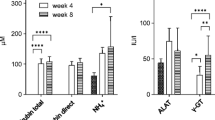Abstract
Hepatic encephalopathy (HE) is associated with typical changes in neurometabolites most likely being caused by an elevated systemic ammonia level. Blood ammonia is a valid overall biomarker of HE and thus is regularly determined in clinical trials. The neurometabolites affected in HE can be assessed in vivo by proton magnetic spectroscopy. The aim of this study was to show the effect of the ammonia lowering drug L-ornithine-L-aspartate (OA) on the cerebral glutamate+glutamine/creatine (Glu+GLN/Cr) ratio. In an open clinical trial (pilot study), 15 patients with stable HE were treated with an infusion of 40 g OA over 8 h (5 g/h). Immediately before and 6–8 (mean 6.8) h after start of the infusion, spectroscopy of the parietal white matter was performed and arterial blood ammonia quantified. Glu+GLN/Cr-ratios correlated significantly with ammonia data (Spearman's correlation coefficient rs = 0.72, p < 0.001). Likewise, the OA induced changes (versus baseline before infusion) in blood ammonia level and in Glu+GLN/Cr-ratios correlated significantly rs = 0.54, p = 0.0375). Magnetic resonance (MR) spectroscopy assesses the neurometabolite variation present in HE. OA induced changes in cerebral Glu+GLN/Cr-ratio were significantly correlated with the drug effects on arterial blood ammonia. These pilot data indicate that MR spectroscopy detects a specific biomarker of HE that may reflect the extent of the cerebral alterations associated with the disease.
Similar content being viewed by others
REFERENCES
Albrecht, J., and Jones, E.A. (1999). Hepatic encephalopathy: Molecular mechanisms underlying the clinical syndrome. J. Neurol. Sci. 170:138–146.
Butterworth, R. (1987). Ammonia in hepatic encephalopathy. Neurochem. Pathol. 6:1–157.
Butterworth, R. (1998). Alterations of neurotransmitter-related gene expression in human and experimental portalsystemic encephalopathy. Metab. Brain Dis. 13:337–349.
Butterworth, R. (2000). Complications of cirrhosis. III. Hepatic encephalopathy. J. Hepatol. 32(Suppl. 1):171–180.
Conn, H.O. (1994). The hepatic encephalopathies. In (H.O. Conn and J. Bircher, eds.), Hepatic Encephalopathy: Syndromes and Therapies, Medi-Ed Press, Bloomington, Illinois, pp. 13–26.
Delcker, A., Jalan, R., Schumacher, M., and Comes, G. (2000). L-ornithine-L-aspartate vs placebo in the treatment of hepatic encephalopathy: A meta-analysis of randomised placebo-controlled trials using individual data [Abstract]. Hepatology 32:604.
Fehér, J., Láng, I., Gógl, A., Varga, L., Varga, L., Tompos, G., and Prónai, L. (1997). Effect of ornithine-aspartate infusion on elevated serum ammonia concentration in cirrhotic patients-results of a randomized, placebocontrolled double-blind multicentre trial. Med. Sci. Monit. 3:669–673.
Frahm, J., Bruhn, H., Gyngell, M.M., Merboldt, K.D., Hanicke, W., and Sauter, R. (1989). Localized highresolution proton NMR spectroscopy using stimulated echoes: Initial application to human brain in vivo. Magn. Reson. Med. 9:79–93.
Haase, A., Frahm, J., Hanicke,W., and Matthaei, D. (1985). 1H NMR chemical shift selective (CHESS) imaging. Phys. Med. Biol. 30:341–344.
Häussinger, D., Laubenberger, J., von Dahl, S., Ernst, T., Bayer, S., Langer, M., Gerok,W., and Hennig, J. (1994). Proton magnetic resonance spectroscopic studies on human brain myo-inositol in hypo-osmolarity and hepatic encephalopathy. Gastroenterology 107:1475–1480.
Hazell, A.S., and Butterworth, R.F. (1999). Hepatic encephalopathy: An update of pathophysiologic mechanisms. Proc. Soc. Exp. Biol. Med. 222:99–112.
Hourani, B.T., Hamlin, E.M., and Reynolds, T.B. (1971). Cerebrospinal fluid glutamine as a measure of hepatic encephalopathy. Arch. Intern. Med. 127:1033–1036.
Huizenga, J.R., Tangerman, A., and Gips, C.H. (1992). A rapid method for blood ammonia determination with a new blood ammonia checker (BAC) II. Clin. Chim. Acta 210:153–155.
Kircheis, G., Nilius, R., Held, C., Berndt, H., Buchner, M., Görtelmeyer, R., Hendricks, R., Krüger, B., Kuklinski, B., Meister, H., Otto, H.-J., Rink, C., Rösch, W., and Stauch, S. (1997). Therapeutic efficacy of L-ornithine-L-aspartate infusions in patients with cirrhosis and hepatic encephalopathy: Results of a placebo-controlled, double-blind study. Hepatology 25:1351–1360.
Kreis, R., Farrow, N., and Ross, B.D. (1990). Diagnosis of hepatic encephalopathy by proton magnetic resonance spectroscopy. Lancet 336:635–636.
Kreis, R., Farrow, N., and Ross, B.D. (1991). Localized 1H NMR spectroscopy in patients with chronic hepatic encephalopathy. Analysis of changes in cerebral glutamine, choline and myo-inositol. NMR Biomed. 4:109–116.
Kreis, R., Ross, B., Neil, A., and Ackermann, Z. (1992). Metabolic disorders of the brain in chronic hepatic encephalopathy detected with H-1 MR Spectroscopy. Radiology 182:19–27.
Laubenberger, J., Häussinger, D., Bayer S., Gufler, H., Henning, J., and Langer, M. (1997). Proton magnetic resonance spectroscopy of the brain in symptomatic and asymptomatic patients with liver cirrhosis. Gastroenterology 112:1610–1616.
Leonhardt, H., and Bungert, H.J. (1972). Therapy of severe hyperammonia (German). Med. Klin. 32:1052–1056.
McIntyre, N. (1987). Ascites and portal hypertension. In (D.J. Weatherall, J.G.G. Ledingham, and D.A. Warrell, eds.), Oxford Textbook of Medicine, Oxford University Press, Oxford, pp. 12236–12244.
Pomier Layrargues, G. (1996). TIPS and hepatic encephalopathy. Semin. Liver Dis. 16:315–320.
Provencher, S.W. (1993). Estimate of metabolite concentrations from localized in vivo proton NMRspectra. Magn. Reson. Med. 30:672–679.
Pugh, R.N. (1992). Pugh's grading in the classification of liver decompensation. Gut 33:1583.
Ross, B., Jacobson, S., Villamil, F., Korula, J., Kreis, R., Ernst, T., Shonk, T., and Moats, R.A. (1994). Subclinical hepatic encephalopathy: Proton MR spectroscopic abnormalities. Radiology 193:457–463.
Sherlock, S., and Dooley, J. (1993). Hepatic encephalopathy. In (S. Sherlock and J. Dooley, eds.), Diseases of the Liver and Biliary System, Blackwell Scientific, Oxford, pp. 86–101.
Zieve, L. (1987). Hepatic encephalopathy. In (L. Schiff and E.R. Schiff, eds.), Diseases of the Liver, Lippincott, Philadelphia, Pennsylvania, pp. 925–948.
Author information
Authors and Affiliations
Corresponding author
Rights and permissions
About this article
Cite this article
Delcker, A., Turowski, B., Mihm, U. et al. Proton MR Spectroscopy of Neurometabolites in Hepatic Encephalopathy During L-Ornithine-L-Aspartate Treatment–Results of a Pilot Study. Metab Brain Dis 17, 103–111 (2002). https://doi.org/10.1023/A:1015468112686
Issue Date:
DOI: https://doi.org/10.1023/A:1015468112686




